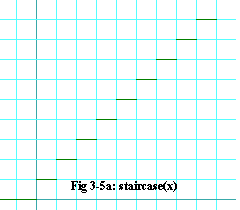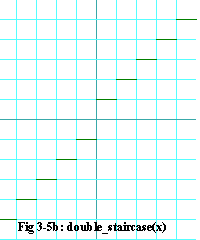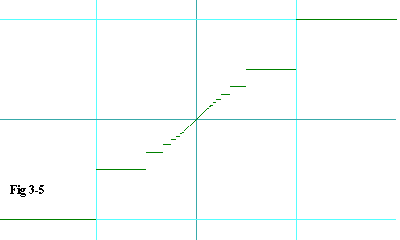

Suppose Marty McFly is riding a westbound train in the year 1885. We can label each point of the track with a real number that expresses how far from the station it is. To make it really useful, we would have to make sure we label all points to the east of the station with negative numbers and all points to the west of the station with positive numbers. The station itself would be at zero.
Likewise we could label all times with real numbers according to how many seconds had elapsed since noon of October 25, 1885. Times before that moment would be negative numbers, times after that moment would be positive numbers, and the moment itself would be time zero.
We have a sense that the position of the front of the train as a function of time is continuous. This is in line with our observation before that nature likes continuity. But what exactly do we mean by that?
In the previous section
We also said that if the above contract holds regardless of what time, s, you happen to choose, then the train's position as a function of time is continuous for all time. That's a pretty strong statement for a train, so let's just say that it's continuous from midnight, October 25, 1885 until midnight, October 26, 1885. In other words, it's continuous at least over the interval of that one day.
It seems that Marty brought his hover-board along on the train and is entertaining himself by scooting up and down the aisle on it. If we mark each point along the length of the train with a real number that indicates how far aft of the cowcatcher that point is (and to make this example work out right, we make all these numbers negative), then Marty's position on the train is a real function of time as well. Call it xmarty(t). And for the same reasons we believe the train's position on the track to be a continuous function of time, we believe that Marty's position on the train is a continous function of time as well (at least on the date in question).
0 /
| Marty
/ ^
/ \ (shown: xmarty = -1.7)
< | | | |
0 -1 -2 -3
The Train (shown: xtrain = 70.5)
| | | | | | |
71 70 69 68 67 66 65
< west The Track > east
Fig 3-4
So what about Marty's position with respect to the tracks? Isn't that also a real function of time too? And how do we establish that function? We simply add the train's position to Marty's position on the train. In equation form, we have:
xcombined(t) = xtrain(t) + xmarty(t) eq. 3.1-1If both functions are continuous, then it seems that this new function should be as well, doesn't it? But can we prove it?
Actually, we can very easily. Remember that we have already proved (back in section 2.2) that the sum of the limits is the same as the limit of the sum. Since the new function is defined simply as the sum of two continuous functions, and since continuity is defined in terms of their limits, it follows immediately that the sum of two continuous functions is continuous. If the two functions are continuous in some places but not in others, then their sum is continuous everywhere where BOTH functions are simultaneously continuous (note that the sum might be continuous at a point where both summands are not, but it doesn't have to be. In other words, both summands being continuous is a sufficient condition for the sum to be continuous, but not a necessary condition). See if you can explain this same line of thought in the contract terms we have been using.
Since the product of the limits is the same as the limit of the products, it is also true that the product of two continuous functions is continuous. Again, if the two functions are continuous in some places but not in others, then their product is continuous everywhere BOTH functions are simultaneously continuous (again, both factors being continuous at a particular point is a sufficient condition for continuity of the product at that point, but not a necessary condition).
When it comes to the quotient of two functions, you have to be careful. Remember that the quotient function is not even defined wherever the denominator function is zero. So the rule is, the quotient of two continuous functions is continuous everywhere that the denominator is not equal to zero. Likewise, if the two functions are continuous in some places and not in others, then their quotient is continuous everywhere that they BOTH simultaneously continuous AND the denominator function is not zero (the analogous rule concerning sufficiency and necessity applies here as well, however, the quotient will never be continuous wherever the denominator is zero).
Let's go back to the train. A certain white-haired professor is also on the train. He set his watch to the station clock at exactly noon. But his watch does not work properly. Sometimes it speeds up and begins to run ahead of the station clock (which we shall assume is accurate), and sometimes his watch slows down until it runs behind the station clock. But the professor's watch always runs forward, never stops, and never jumps ahead instantaneously. In fact, the time his watch shows, which we shall call w(t), is a continuous function of the station clock time. In addition, if you knew the exact eccentricities of the watch, as the professor does, you could, at any time, deduce the time that the station clock reads by knowing the time on the professor's watch. And the function that takes us from the time on the professor's watch to the time on the station clock we shall call w-1(t). And this function is continuous as well.
Remember the function xtrain(t)? It is the position of the train based upon the station clock time. So what is the position of the train based upon the professor's watch time? If tp is the time the professor's watch reads, then that would be:
xpwatch(tp) = xtrain(w-1(tp)) eq. 3.1-2That is, first you apply the function that takes you from the professor's watch time to the station clock time, (that is, the station clock time, t, is given by
So what about the composite of two functions? For example, suppose
But what about when the two functions are continuous in some places but not others? For example,
______
f(g(x)) = f(x2) = Öx2 + 1 eq. 3.1-3
In this example, you can stick in any real value for x and
get a valid value for the composite, even though f(x) is not
even defined for
And what about taking the opposite composite?
_____
g(f(x)) = g(Öx + 1) = x + 1 eq. 3.1-4
But notice that this composite is only defined for
So the rule about where a composite is continuous is more complicated than it was for sums, products, or quotients. It is this: the composite of two functions, f(g(x)), is continuous at every x at which g(x) is continuous AND f is continuous at g(x).
A little while ago I assured you, but without proof, that
_____
f(x) = Öx + 1
is continuous wherever
_
h(x) = Öx
is continuous wherever
_____
f(x) = Öx + 1
must be continuous wherever
_
h(x) = Öx
is continuous.
First, we have
So now we know that g(x) is continuous everywhere. For now
we are assuming that
_____ ____
f(x) = Öx + 1 = Ög(x) = h(g(x)) eq. 3.1-5
Using what we have learned so far about composite functions, can you argue
that f(x) is continuous wherever
And now the hard part that we've saved for last -- proving that
In your e inequality, you ought to see the difference of two square roots. Looks pretty hard, eh? The trick in problems like this is to find the algebraic munging that you can do to it to make the hard thing look easier. You're going to use an error variable again. Let error be the difference of the two square roots. So your new e inequality should relate the absolute value of error to e.
Now take the equation you made that equates error to the difference of the two square roots and algebraically munge it so that there is only one square root on either side of the equal sign. Got that?
Now square both sides of that equation. Multiply out the square of the sum. Do you see that some of the terms are multiplied by of error (or its square) and some are not? Move all the ones that have error in them to one side of the equation, and move all the others to the other side.
Look at the side without the error terms. Does it look familiar? Will it look even more familiar if you take the absolute value of both sides? Doesn't that give you a recipe for d from error? And if you can get d from error, can you argue that you can also get it from e?
But note that your expression for d has a
Öa
in it. So your recipe for d only works where
Öa is defined, and that is only where
Prove that if n is any counting number, then
Step 1: Prove it for
Step 2: Prove that if you can get to the nth rung of the
ladder, then you can get to the n+1st rung of the ladder. Once
you have proved that and done step 1, it means that you can get to any rung
of the ladder, right? So what do you have to do to show this?
Going from the nth rung to the n+1st rung presupposes
that you were able to get to the nth rung. So you presuppose
that
xn+1 = (x)(xn)The right-hand side of the above equation shows that
So if
1) Let the function, f(x) be:
1
f(x) =
x
Clearly f(x) can't be continuous at
2) Let the function, g(x) be:
x2 - 1
g(x) =
x - 1
This function is clearly not continuous at
I promised you earlier that I would show you examples of functions that
were discontinuous in a variety of ways. We've seen that our friend,
the unit step function, u(x), from the last section is continuous
everywhere except at
¥
staircase(x) = å u(x - j) eq. 3.1-6
j=0
|
For all negative x, staircase(x) is zero. For positive
x, staircase(x) is 1 for
|

|
|
Now, let double_staircase(x) be as follows: double_staircase(x) = staircase(x) - staircase(-x)You can see double_staircase(x) in figure 3-5b. There is nothing especially remarkable about this function, but I am about to use it to make a most unusual function. |

|
|
This new function,
which you can call whatever you like, is made by arbitrarily setting
it to zero at
|

|
How about a function that is discontinuous everywhere. Suppose you had
a function that assigned a value of 1 to any real number that
can be represented by a terminating decimal, and assigned 0 to
any real number that cannot. So at
I promised you also a function that is continuous at a single point
only. Try this. Take the function given above that is discontinuous
everywhere and multiply it by x2. The resulting function
is continuous only at
Finally, here is a continuous function that cannot be graphed. You will have to recall your understanding of the sin function for this. This function is described as an infinite sum of sin terms. The way we define infinite sums is this. The sum of an infinite number of terms is the limit (if it exists) of the partial sums of the first n terms, as n goes to ¥. Here is the formula:
¥
å 2-n sin(3nx) eq. 3.1-7
n=1
The sin(x) function, you probably remember, is that ripply thing
that goes on smoothly and evenly forever. Well this takes a ripple and
adds a smaller yet faster ripple to that, then adds a still smaller and
still faster ripple to that, and so on. I shall state without proof
at this time that the function in 3.1-7 is defined everywhere and is
continuous everywhere. But it has a fractal nature to it, and hence
cannot be graphed. Fractals have been much in the news this past
decade, but this function, and a weird property it has (which I will
discuss in a later section) have been known for over a century.
email me at hahn@netsrq.com